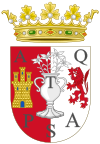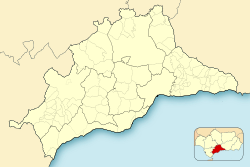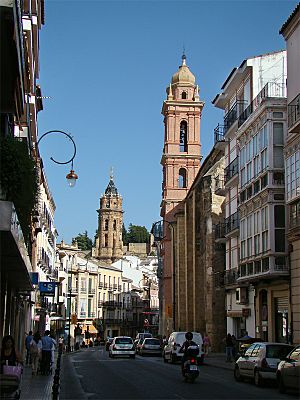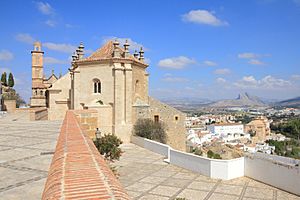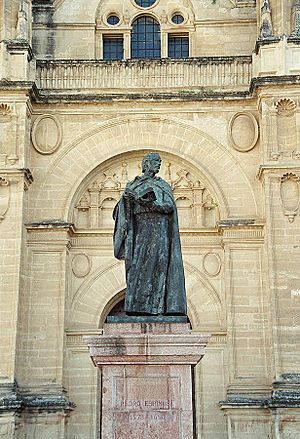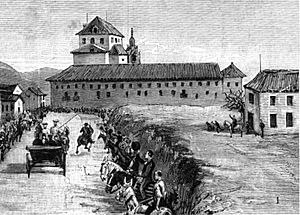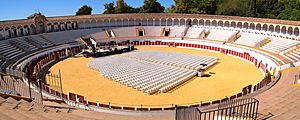Antequera facts for kids
Quick facts for kids
Antequera
|
|||
|---|---|---|---|
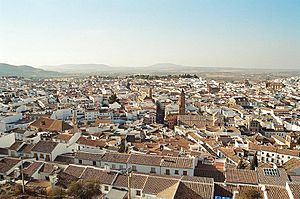 |
|||
|
|||
| Motto(s):
For her love
|
|||
| Sovereign state | |||
| Autonomous community | |||
| Province | |||
| Comarca | Antequera | ||
| Area | |||
| • Total | 749.34 km2 (289.32 sq mi) | ||
| Elevation | 575 m (1,886 ft) | ||
| Population
(2018)
|
|||
| • Total | 41,154 | ||
| • Density | 54.9203/km2 (142.2430/sq mi) | ||
| Demonyms | antequerano, -na | ||
| Website | www.antequera.es | ||
Antequera is a city and municipality in the province of Málaga, located in Andalusia, Spain. It is often called "the heart of Andalusia" because it sits right in the middle of important cities like Málaga, Granada, Córdoba, and Seville.
This city is famous for the Antequera Dolmens Site, which is a special place recognized by UNESCO as a World Heritage site. In 2018, about 41,154 people lived in Antequera. The city covers a large area of 749.34 square kilometers and is located 575 meters above sea level. It is the biggest city in the interior of Málaga province.
Antequera is well-connected to other major cities. It is about 45 km from Málaga and 115 km from Córdoba. You can travel between these cities by high-speed train or motorway. Its central location makes it a key spot for transportation and logistics. It has several industrial parks and a new Logistics Centre for Andalusia.
The land around Antequera, called the Vega de Antequera, is very fertile. The Guadalhorce River waters this area, helping farmers grow lots of cereals, olives, and vegetables.
Near the city, you'll find the amazing natural reserve of El Torcal. This area is known for its unique limestone rocks and is one of Europe's most important karst landscapes. It's a popular spot for climbers and nature lovers.
Antequera also has a rich history with many old buildings and archaeological sites. These include the ancient dolmens of Menga, Viera, and El Romeral. You can also see many churches, convents, and palaces built in different styles over the centuries.
The city played an important role in the history of Andalusian nationalism. Key agreements like the Federal Constitution of Antequera in 1883 and the Pact of Antequera in 1978 were made here. These events helped Andalusia gain its autonomy.
Contents
Discover Antequera's Geography
City Location and Landscape
Antequera is located about 47 km north of Málaga. It sits at the foot of the El Torcal and Sierra de la Chimenea mountains. The city overlooks a fertile valley, with the Sierra de los Torcales to the south and the Guadalhorce River to the north.
The municipality of Antequera is the largest in the province of Málaga, covering 817 square kilometers. In 2002, its population was around 41,197 people.
Natural Wonders Nearby
Close to Antequera, you can visit the saltwater Fuente de Piedra Lagoon. This lagoon is one of the few places in Europe where greater flamingos nest.
Another amazing natural site is the Torcal. This nature reserve features incredible limestone rock formations. It's a popular place for climbing and exploring.
Across the Guadalhorce River, you'll see Peña de los Enamorados, which means "The Lovers' Rock." This rock is named after a romantic legend. The story tells of two young Moorish lovers from rival families who jumped from the rock while being chased by the girl's father.
Surrounding Villages
The area around Antequera includes several smaller villages. These include Bobadilla, Cañadas de Pareja, Cartaojal, Colonia de Santa Ana, La Higuera, La Joya, Los Llanos, Los Nogales, and Villanueva de Cauche.
Antequera Through History
Prehistoric Times
| UNESCO World Heritage Site | |
|---|---|

Panorama of Dolmen of Menga site
|
|
| Criteria | Cultural: i, iii, iv |
| Inscription | 2016 (40th Session) |
| Area | 2,446.3 |
| Buffer zone | 10,787.7 |
On the northern edge of Antequera, you can find two very old burial mounds. These are called the Dólmen de Menga and the Dólmen de Viera. They were built around 3000 BCE, making them some of the largest structures of their kind in Europe.
The Dólmen de Menga is huge, about twenty-five meters wide and four meters high. It was built using thirty-two giant stones, with the largest weighing around 180 tonnes. This structure likely served as a grave for important families. When it was explored in the 1800s, archaeologists found the skeletons of hundreds of people inside.
Another dolmen, the Dólmen del Romeral, is located outside the city. It dates from about 1800 BCE and was built with many smaller stones.
A significant Bronze Age village called Los Silillos was also discovered a few miles north of Antequera.
From the 7th century BCE, the region was settled by the Iberians. They had cultural and economic connections with the Phoenicians and Greeks. Later, the Iberians mixed with wandering Celts, forming the Celtiberians.
In 2016, the dolmen complex of Menga, Viera, and Romeral was named a World Heritage Site by UNESCO. This recognition also includes the Peña de los Enamorados (Lovers' Rock) and El Torcal.
Ancient Roman Period
The city was known to the Ancient Romans as Anticaria or Antiquaria. It was part of the land of the Turdetani, who were a very advanced group of Prehistoric Iberians. The Carthaginians also had a presence along the coast, with their port of Malaca (Málaga).
The Roman Republic gradually took control of the area after the Second Punic War. Anticaria's region became part of Hispania Ulterior in 197 BCE. The Romans heavily influenced the area, and many Roman settlements were established. The city's current street layout still shows signs of the Roman town. Under Roman rule, Anticaria was especially known for its high-quality olive oil.
Later, during the fall of the Roman Empire, the area was taken over by the Vandals and then the Visigothic Kingdom.
Medieval Era
The Arab invasion of the Iberian Peninsula began in 711. Anticaria was conquered around 716 and became part of the Umayyad Caliphate. It was renamed Medina Antaquira, which means "Antaquira City" in Arabic. During this time, the region was mostly Muslim but generally tolerant of other religions.
As the Reconquista (the Christian reconquest of Spain) progressed, Medina Antaquira became an important border town for the remaining Nasrid Emirate of Granada. To protect against Christian attacks, strong defenses were built, including a Moorish castle overlooking the city. For about 200 years, Medina Antaquira faced many attacks.
On September 16, 1410, after a long siege, the city surrendered to a Castilian army led by Prince Ferdinand of Trastámara. The Muslim population had to leave their homes. They were allowed to sell their belongings and were given animals to carry their goods.
After the conquest, Antequera became part of the Kingdom of Seville. The city's population grew significantly after the conquest of Málaga in 1487 and Granada in 1492. This was because people no longer worried about military attacks.
Early Modern Growth
In the 16th century, Antequera became a major center for growing cereals. Its fertile land, watered by the Guadalhorce, helped feed Málaga. The city's economy shifted from military defense to agriculture.
Antequera grew into an important trading town. It was a crossroads connecting Málaga, Granada, Córdoba, and Seville. Because of its location, successful farming, and skilled craftspeople, Antequera was called the "Heart of Andalusia." During this time, many new churches and houses were built. The oldest church, the Iglesia San Francisco, was built around 1500.
In 1504, the Real Colegiata de Santa María la Mayor university was founded. It became a gathering place for important writers and scholars of the Spanish Renaissance. A group of poets, including Pedro Espinosa, Luis Martín de la Plaza, and Cristobalina Fernández de Alarcón, emerged from this period. Many artists also worked on the numerous churches built in the city.
More churches and convents were built until the 18th century. Today, there are 32 religious buildings in the city. Wealthy citizens also built grand palaces in the Spanish Baroque style.
Antequera's prosperity began to decline in the late 17th and early 18th centuries. Spain faced economic challenges, which affected the city's ability to fund new construction projects.
Recent History
From the mid-18th century, Spain began to recover economically. In Antequera, textile production became an important industry. However, challenges like yellow fever in 1804 and the Napoleonic wars caused setbacks.
In the 1960s, the nearby Costa del Sol became a popular international tourist destination. This led to a new economic boost for Antequera. Today, the city is an important center for tourism and culture in Spain.
Main Sights to See
Religious Buildings
- Church Real Colegiata de Santa María la Mayor (1514–1550): This is a national monument. It shows a mix of late Gothic and Renaissance styles. Stones from an old Roman town were used to build its façade.
- Church Real Colegiata de San Sebastián (built from 1548): Originally Renaissance, it now has a Baroque bell tower and a Neoclassical interior.
- Convent of Madre de Dios de Monteagudo (1747–1761): This convent has a beautiful Baroque bell tower.
- Convent of La Encarnación (1580): Built in a mix of Mannerist and Mudéjar styles.
- Convent of Belén (early 16th century).
- Church of San Pedro (16th century): Shows signs of an older Gothic building.
- Royal Monastery of San Zoilo (founded in 1500): A Gothic-style building declared a national monument.
- Church of St. John the Baptist (finished in 1584): Has a simple outside but a very detailed Baroque interior.
- Church of Santiago (1522).
- Church of the Carmen (1583–1633): Features Mannerist-Baroque style with beautiful altarpieces from the 18th century.
- Chapel of the Virgen del Socorro (1715): A small, separate church in the port area.
Other Interesting Places
- Alcazaba: A Moorish fortress built in the 14th century on top of old Roman ruins.
- Palace of Nájera: This 18th-century palace now houses the Municipal Museum.
- The Bullring: Built in 1848 and rebuilt in 1984. Its style reflects the city's varied architecture.
- Arco de los Gigantes ("Giants' Arch"): Built in 1595 to honor King Philip II of Spain. It includes stones from Roman buildings.
- Roman Baths: You can see the remains of excavated Roman baths in the southeast of the city.
- Roman Villa of Estación: Dates from the 1st century BCE to the 4th century CE.
Antequera's museums hold about 80% of all the art treasures in the province of Málaga. This makes it a very important cultural center in Andalusia.
In the eastern part of the city, there is one of Spain's largest burial mounds from the Bronze Age. It has underground chambers that go down about 20 meters. This is the Dólmen de Menga.
Antequera's Economy
Historically, Antequera's economy was based on farming. People grew olives, grain, and produced wool. They also made furniture. In the mid-19th century, the city produced fabrics like flannel, as well as paper, leather, silk, and soap. There was also a big trade in grain, fruit, olive oil, and local marble. A large sugar industry started in 1890.
Today, tourism is the main industry in Antequera. More and more visitors from around the world come to explore the city's history and natural beauty.
Getting Around Antequera
Antequera has two train stations. The Antequera-Ciudad station serves local trains between Seville and Almería. The Antequera-Santa Ana station is for high-speed trains connecting to Granada and the Madrid–Málaga line.
Famous People from Antequera
- Juan de Pareja (c.1606–1670): A Spanish Baroque painter who was a student of Diego Velázquez.
- Geronimo de Bobadilla (1630–1709): A Spanish Baroque painter.
- José Guerrero de Torres (1641–1720): A Roman Catholic bishop.
- Kiti Mánver (born 1953): A Spanish actress.
Sports Stars
- Antonio González Álvarez (born 1940): A Spanish retired footballer known as Chuzo, who played 233 games.
- Kiko Olivas (born 1988): A footballer who has played over 450 games.
- Sergio Calatayud Lebrón (born 1990): Known as Cala, a Spanish footballer who has played over 300 games.
Sister Cities
| Town | State/Region | Country |
|---|---|---|
| Agde | ||
| Oaxaca |
See also
 In Spanish: Antequera para niños
In Spanish: Antequera para niños



